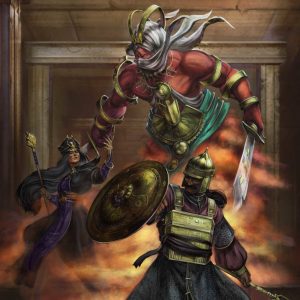Arburg: The Kingdom of Craftsmen
If founding legends are to be believed, Arburg started very small: a single house of pioneers, among the first to have left the warmth of the Bounty, once the Long Winter had begun to recede. The legendary head of the family, Arbeus Beiter, was a woodsman, skilled in both hunting and woodworking. Confident in his skill, he led his family east to claim land unclaimed by those who called themselves nobles and Kings. Braving weather, beasts and isolation from civilization, the Beiters found shelter in a natural passage, rich in water, wood and game, and with a small patch of land rich enough to sustain a family with a modest supply of vegetables.
By the time the mass migration from the shores of the Bounty begun, the Beiters were well settled. The family’s stories claim their forefathers built small houses, empty, save for stored wood, intended to make the land appear settled already and unable to sustain more. As caravans and convoys became more frequent, however, the family saw multiple opportunities. First, they expanded their small farmhouse, building a second floor to serve as an inn, while serving guests with modest but warm meals and spirits made from berries. As no roads had been opened yet, however, the rough, uneven paths that the caravans of settlers were forced to take offered an opportunity that would define the future of the family and the entire area. Skilled carpenters by necessity in their isolation, the Beiters expanded their house further with a woodwork station that made carriage repairs for passing convoys.
The ruse of the empty houses would not hold forever. Eventually, others settled the surrounding land, and while the Beiters today claim they were approved by their forefathers, it is hard to give this claim much credit. Still, the truth is that the Beiters remained the dominant force of the area, not only because of their older claim or great numbers, but also because of their wealth. The ‘Beiter Woodworks Workshop’ had gained fame through settlers but more importantly, it had gained the admiration and respect of caravan drivers. Once trade became frequent among new-found Kingdoms, many were those that preferred passing by the Beiters for rest and repairs both, if their route brought them close.
As its reputation grew, the workshop attracted more craftsmen around it, all seeking clientele in the convoys that visited the Beiters. Blacksmiths offered repairs to tools and shoeing horses, leatherworkers made harnesses and saddles or mended those that could be mended. It did not take long for riches to start flowing through Arburg, as the village came to be known, and, as neighboring powers and Kingdoms grew, it was not long before covetous eyes fell upon it. It was chance that saved its independence. A group of masons, last employed by the Order of the Sealed Temple for the building of a Priory, had heard of this society of craftsmen and came to Arburg, escorted by Templars. Once they realized the situation, the Knights made sure their presence became wildly known to dissuade claims of nobility on the land. The descendants of the Beiters today claim that it was their own decision, wishing to preserve what had become a haven for craftsmen and artisans but records show that very soon after, Klaus Beiter, head of the family at the time, produced papers that proved his noble origins from the Old Dominion. Since most Beiters had married into the other artisan families that had settled around them, the higher and lesser nobility of the area was born overnight. Not surprisingly, construction of a small Sealed Temple priory begun almost at the same time.
The cooperation with the Orders ensured Arburg’s prosperity. Under their protection, it wasn’t long until the crafters united under the Beiter house and started producing their own carriages, equipped with the experience of generations repairing their parts, be they wood, metal or leather. In time, the Orders supported an Imperial Decree that allowed the Beiters to form their own Guild of craftsmen and traders, expanding Arburg’s influence and ensuring its coffers would be full. The preference of carriage drivers soon became standard practice for most convoys, and Arburg became a powerhouse of trade, not simply as a station for passing convoys, but also as a massive exporter of its many produces.
Today, Arburg houses the largest craftsman and industrial complex of the Kingdoms, producing everything from furniture, boots and clothes, to armor, weapons and, it is claimed, the best shields of the Kingdoms, sustained and advanced by numerous artisan schools and opportunities for apprenticeships under true master craftsmen. Its caravans reach even the furthest corners of the Kingdoms and the lands of the Russ Principalities, while rumors claim they have standing trading agreements even with the City States. While the Beiter House still rules, it is very much held in place by the local Guild’s council. While most members of the Guild’s council are part of the local nobility, and distant relatives to the Crown, the Guild is open to successful traders and artisans of humble origins, even if in a limited manner. Old Conclave nobility looks down upon such relationships with commoners, but still, the Guild controls the area with the iron fist of a masterfully equipped army and an array of impressive war engines, well settled on its mighty walls. Many claim that it is their longstanding coalition with the Orders that keep Arburg from selling their weapons of war and siege but it is perhaps a simpler and truer explanation to assume that Arburg wants to keep its advantages in war to itself.
The name-sake capital of the Kingdom is a marvel, perhaps not of beauty, but definitely of ingenuity. The landscape around it is filled with artisan workshops that toil day and night, with cranes taller than buildings constantly at work to make sure that newly produced goods are moved, stored and loaded fast. Its massive trading station has a unique system for loading and unloading goods, compatible only with the carriages produced in what is known as ‘Arburg style’. But perhaps the most impressive of its features are its walls, famed for the genius of their design. They are a complex maze-like construction that runs through all districts of the city, instead of simply encompassing its entirety. Not only does this make it impossible to conquer the city completely, save by piece by piece, but it also provides an unhindered passage for troops to move to all sides of the city, with retractable bridges to isolate each section if needed. Even the buildings are part of the city’s defenses, designed to force potential besiegers into narrow corridors, where murder holes on nearby walls await and rows of spears connected to cog-based devices stand ready to stab blindly and repeatedly, operated by crews of twos or threes. If rumors are to be believed, numerous other traps await would-be conquerors; some of the larger buildings are designed to be brought down upon unsuspecting enemies with the pull of a single lever. Some key sections of the walls can be moved, isolating enemies or changing viable routes through the city within an hour. Entire streets await to be collapsed into spiked pits, taking enemy regiments with them.
Seemingly unassailable, such tall tales are hard to believe and not all is bright or safe in Arburg’s future. The Orders’ protection is long gone, as their influence has all but evaporated, and the Beiter dynasty is desperately lacking in allies within the Conclave. The modern aggression of the Palatinate could find fertile ground in the form of the Spire Merchant Princes. Already voices claim in the Conclave that Arburg trades with the Spire of the Devil’s Finger and the lack of evidence seems not to dissuade those raising them. What’s worse is that the events of Nepenthe have many guild members raise concerned voices. Spire forces are seen outside the Devil’s Finger, they say, and their patrols do not seem content to staying close to the Spire itself, urging the Beiter House to not wait, as Brandengrad did, but instead strike first. While such propositions are dangerous, the fact remains that Arburg is a massive cache of various resources at the borders of a Spire and its silence can no longer be taken for granted.

The Kingdom of Arburg can be an excellent thematic battlefield, with an urban terrain, narrow corridors for bloody encounters and patches of difficult terrain for collapsed buildings. Arburg Characters would fittingly carry heirlooms such as the Standard of Steel or the Finite State Apparatus, while a color scheme of green, white and brown would match the city’s coat of arms, for those who want that extra flare of lore in their army. Whether your Arburg wars against Kingdom rivals, the Spire of the Devil’s Finger or a warband of Dweghom who want to compare craftsmanship in that unique manner of theirs, Arburg awaits brave commanders to lead its armies!












